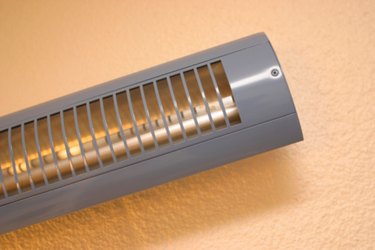
Baseboard heaters provide convenient sources of electric heat. They may operate on either 120 or 240 volts, depending on the amount of heat required and the size of the space to be heated. Electric baseboard heaters can provide supplemental heating to areas of a home removed from the thermostat controlling the furnace, supplying heat when the room grows too cold. Understanding the electrical load of baseboard heaters is essential, especially while wiring more than one in the same room.
Step 1
Find the power rating in watts of each baseboard heater and determine if the heater operates on 240 or 120 volts. Each heater should have a metal tag or plate that specifies its electrical characteristics. You may have to look behind an access panel to find it.
Video of the Day
Step 2
Divide the power rating in watts for each baseboard heater by the voltage specified on the unit's tag. For example, for a 2,500-watt baseboard heater supplied by 240 volts, divide 2,500 by 240 to get 10.42 amps. The load of this individual heater is 10.4 amps.
Step 3
Add up the loads of all the baseboard heaters on the same circuit breaker to find the total load of the baseboard heaters. Three, 2,500-watt baseboard heaters on the same circuit total 10.4 x 3 = 31.2 amps.
Tip
The total load on a circuit is used for sizing the circuit breakers and wiring.
Video of the Day